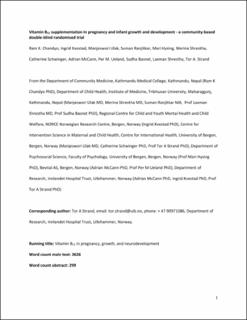| dc.contributor.author | Chandyo, Ram K. | |
| dc.contributor.author | Kvestad, Ingrid | |
| dc.contributor.author | Ulak Chandyo, Manjeswori | |
| dc.contributor.author | Ranjitkar, Suman | |
| dc.contributor.author | Hysing, Mari | |
| dc.contributor.author | Shrestha, Merina | |
| dc.contributor.author | Schwinger, Catherine | |
| dc.contributor.author | McCann, Adrian | |
| dc.contributor.author | Ueland, Per Magne | |
| dc.contributor.author | Basnet, Sudha | |
| dc.contributor.author | Shrestha, Laxman | |
| dc.contributor.author | Strand, Tor Arne | |
| dc.date.accessioned | 2024-02-23T15:11:12Z | |
| dc.date.available | 2024-02-23T15:11:12Z | |
| dc.date.created | 2023-05-31T22:33:20Z | |
| dc.date.issued | 2023 | |
| dc.identifier.citation | The Lancet. 2023, 401 (10387), 1508-1517. | |
| dc.identifier.issn | 0140-6736 | |
| dc.identifier.uri | https://hdl.handle.net/11250/3119726 | |
| dc.description.abstract | Background: Vitamin B12 is required for healthy infant growth and development, but low and marginal vitamin B12 status is endemic in low-income and middle-income countries. We aimed to measure the effect of vitamin B12 supplementation from early pregnancy until 6 months post partum on infant growth and neurodevelopment. Methods: In this community-based, double-blind, placebo-controlled trial, we randomly assigned (1:1) 800 pregnant women (aged 20-40 years) who were up to 15 weeks pregnant-recruited from home visits and outpatient departments at three hospitals in Nepal-to daily supplementation with 50 μg oral vitamin B12 or placebo until 6 months postpartum. Independent scientists generated the list that linked allocation to participants' study identification number. Participants were masked to group assignment and all investigators were masked until data cleaning was completed. The primary outcomes were length-for-age Z score (LAZ) at age 12 months and the cognitive composite score of the Bayley Scales of Infant and Toddler Development (3rd edition) at age 6 months and 12 months. The primary and secondary outcomes, including adverse events, were assessed in the intention-to-treat population, for all participants with available outcome data. This trial is registered with ClinicalTrials.gov, NCT03071666. Findings: 800 eligible pregnant women were enrolled in the trial between March 28, 2017, and Oct 15, 2020, with 400 women randomly assigned to each group. Follow-up was completed on May 18, 2022. At baseline, 569 (71%) of 800 women had plasma vitamin B12 indicating low or marginal status (<221 pmol/L). We found no effect of vitamin B12 on the primary outcomes. The mean LAZ at age 12 months were -0·57 (SD 1·03) in the B12 group and -0·55 (1.03) in the placebo group (366 infants in the vitamin B12 group vs 363 infants in the placebo group) with a mean difference of -0·02 (95% CI -0·16 to 0·13). The mean cognitive composite scores were 97·7 (SD 10·5) in the B12 group and 97·1 (10·2) in the placebo group, with a mean difference of 0·5 (95% CI -0·6 to 1·7) measured in 364 and 361 infants. Stillbirths or infant deaths occurred in three (1%) of 374 women in the vitamin B12 group and nine (2%) of 379 women in the placebo group. Interpretation: Although vitamin B12 deficiency was prevalent in our study population and vitamin B12 supplementation from early pregnancy substantially improved vitamin B12 status, supplementation did not improve infant growth or neurodevelopment. Our findings support the current WHO recommendations of no routine vitamin B12 supplementation during pregnancy. | |
| dc.description.abstract | The effect of vitamin B12 supplementation during pregnancy on infant growth and development in Nepal: a community-based, double-blind, randomised, placebo-controlled trial | |
| dc.language.iso | eng | |
| dc.title | The effect of vitamin B12 supplementation during pregnancy on infant growth and development in Nepal: a community-based, double-blind, randomised, placebo-controlled trial | |
| dc.title.alternative | The effect of vitamin B12 supplementation during pregnancy on infant growth and development in Nepal: a community-based, double-blind, randomised, placebo-controlled trial | |
| dc.type | Peer reviewed | |
| dc.type | Journal article | |
| dc.description.version | acceptedVersion | |
| dc.source.pagenumber | 1508-1517 | |
| dc.source.volume | 401 | |
| dc.source.journal | The Lancet | |
| dc.source.issue | 10387 | |
| dc.identifier.doi | 10.1016/S0140-6736(23)00346-X | |
| dc.identifier.cristin | 2150630 | |
| dc.relation.project | Norges forskningsråd: 223269 | |
| cristin.ispublished | true | |
| cristin.fulltext | postprint | |
| cristin.qualitycode | 2 | |
